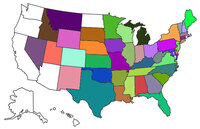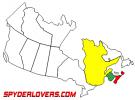You
CANNOT go by the '
look' of a radial tire, especially one like the Q5's - looks can be very deceiving!

With these types of car tires, their very construction means that they'll bulge the sidewalls at the contact patch a tad more than you might be used to; but it's that bulge, their radial construction, and the lower pressure (especially vs those in the more common 'bias ply' tires that many motorcycles still run) that keeps more of their designed contact patch firmly planted on the road providing the traction you need!

And without a tire pressure gauge of some sort, most of the time
no-one can tell just by '
looking' at a radial tire how correct the pressure inside it may be for the load it's carrying.... well, not unless the rim is obviously contacting the ground, anyway!

If you
DON'T see a bulge like that on the sidewalls of a similarly constructed radial car tire, there's a good chance that tire might be over-inflated - but as I mentioned earlier... without that tire pressure gauge, looks can be very deceiving - and as you now know, even WITH a tire pressure gauge, the way the sidewalls bulge (or not

) can also be very misleading!

Those 'looks' can be
almost as deceiving as a '
butt dyno'!!

Many who've become used to the '
feel' of running on over-inflated tires might '
feel' that their Spyder/Ryker '
feels' a bit soft & spongy when they first try running the '
much closer to correct for the load' pressures that we've been suggesting here, but unless they & their load weigh in at something over about 600 pounds, it's very unlikely that anything between 16psi & a max of 20 psi is likely to be too low for a 'real' auto tire on a Spyder with a higher load rating than that of the OE Spec Kendas (even 8 psi didn't result in truly adverse effects when run in a 'real' tire, but that
was a bit low!

); so given a little persistence & saddle time, those things you've already started to notice, like the advantages of the improved traction, ride, & handling; the greater traction under all conditions; the reduced tendency for hydroplaning in the wet; the greater puncture resistance, and the reduced '
centre of tread wear' that comes with running those recommended 'lower pressures commensurate with the lighter loading' that makes the tire look under-inflated will usually overcome the ingrained expectation for less traction, harsher ride, & greater tire wear that the '
looks' or '
butt dyno' biased by any serious length of time that running pressures too high for the load might bring!

Over to you!





 Reply With Quote
Reply With Quote


 With these types of car tires, their very construction means that they'll bulge the sidewalls at the contact patch a tad more than you might be used to; but it's that bulge, their radial construction, and the lower pressure (especially vs those in the more common 'bias ply' tires that many motorcycles still run) that keeps more of their designed contact patch firmly planted on the road providing the traction you need!
With these types of car tires, their very construction means that they'll bulge the sidewalls at the contact patch a tad more than you might be used to; but it's that bulge, their radial construction, and the lower pressure (especially vs those in the more common 'bias ply' tires that many motorcycles still run) that keeps more of their designed contact patch firmly planted on the road providing the traction you need!  And without a tire pressure gauge of some sort, most of the time no-one can tell just by 'looking' at a radial tire how correct the pressure inside it may be for the load it's carrying.... well, not unless the rim is obviously contacting the ground, anyway!
And without a tire pressure gauge of some sort, most of the time no-one can tell just by 'looking' at a radial tire how correct the pressure inside it may be for the load it's carrying.... well, not unless the rim is obviously contacting the ground, anyway! 
 ) can also be very misleading!
) can also be very misleading!  ); so given a little persistence & saddle time, those things you've already started to notice, like the advantages of the improved traction, ride, & handling; the greater traction under all conditions; the reduced tendency for hydroplaning in the wet; the greater puncture resistance, and the reduced 'centre of tread wear' that comes with running those recommended 'lower pressures commensurate with the lighter loading' that makes the tire look under-inflated will usually overcome the ingrained expectation for less traction, harsher ride, & greater tire wear that the 'looks' or 'butt dyno' biased by any serious length of time that running pressures too high for the load might bring!
); so given a little persistence & saddle time, those things you've already started to notice, like the advantages of the improved traction, ride, & handling; the greater traction under all conditions; the reduced tendency for hydroplaning in the wet; the greater puncture resistance, and the reduced 'centre of tread wear' that comes with running those recommended 'lower pressures commensurate with the lighter loading' that makes the tire look under-inflated will usually overcome the ingrained expectation for less traction, harsher ride, & greater tire wear that the 'looks' or 'butt dyno' biased by any serious length of time that running pressures too high for the load might bring! 

 .... 110% ..... Peter you beat me to it today .... Thanks .... Mike
.... 110% ..... Peter you beat me to it today .... Thanks .... Mike 

